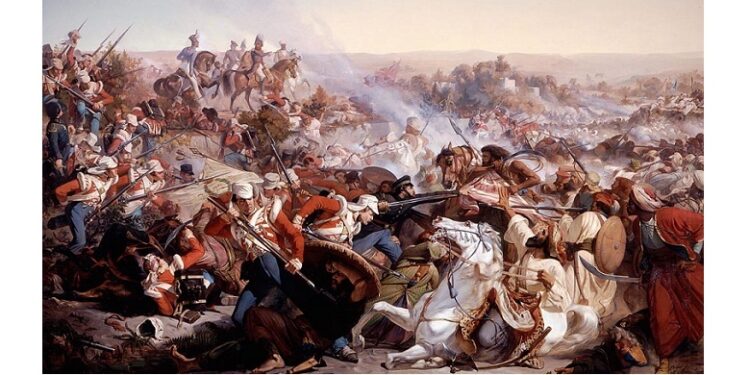
“Sheedian Wari Larrae” – this newly learned name of the Miani battle pushed me to ponder over some questions. Were the Talpur rulers even willing to fight? If they were not, then who fought at the Miani battle?
Zaffar Junejo
On the 12th of February 2022, I was at the Miani battlefield. This was the site of the British East India Company’s conquest of Talpur-ruled Sindh, led by Charles Napier.
Now, the area is also famous for floriculture. The winter day ended quickly and the dusk wrapped the flower-covered area. Red roses that shone in the day now looked cherry colored. The sporadic shadows of Babul tresses transitioned the red color of roses into merlot. The sunset brought silence, and darkness rushed to drape the terrain. Back from the rose fields, I saw a tea stall near the Miani War Memorial (Chandian Wari Dhevrri). I went there.
It apparently looked deserted, but I saw a bearer. Perhaps he was the owner. I asked him to bring me a cup of tea. He gave me a cup, and also brought one cup for himself. He was in a mood to converse. So, I started and asked him about the Miani War. He stared at me in confusion, then told me that he only knew one war: “Hekrri Larrae – Sheedeuin Wari” (the battle of Sheedis or African-origin people).
His reply opened new vistas for me to explore. He, however, turned to another topic. He told me that his tea-stall was dependent upon flower-picking laborers. Now the season would be off. Then in a monologue, he said: “Dhandho Shud” (Business Zero). While he was in conversation with me, I noticed that he attentively rolled his emerald stone ring worn on his right hand’s thumb. Just to carry on the conversation, I enquired from him about the benefits of wearing stones. He held the teacup in his hands, and, in earnest, whispered that it was a gift from Egypt, and its holder became brave. He took gutka (betel quid) packed in a tiny plastic bag from the side pocket of his light blue-colored long shirt. He poured a small portion in his mouth, chewed slowly, and cleaned his hands with his unkempt hair. He expected from me that I should utter a few words as the conversation ought to continue. However, I was thinking about the name Sheedian Wari Larrae, which he had used a little earlier. He took my silence as a discouraging gesture and decoded it as an end to the conversation. And so, he quickly stood up and gathered the cups.
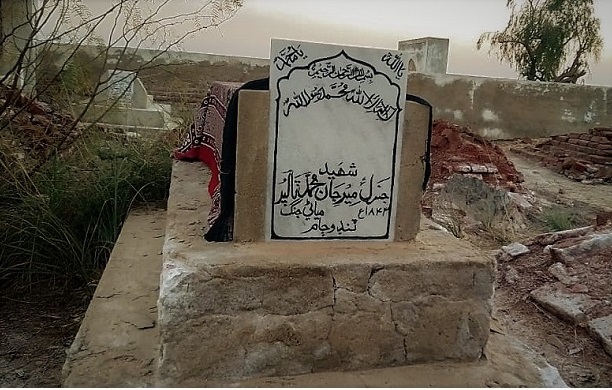
“Sheedian Wari Larrae” – this newly learned name of the Miani battle pushed me to ponder over some questions. Were the Talpur rulers even willing to fight? If they were not, then who fought at the Miani battle?
I reached home, and quickly leafed through Qadir Bux Nizamani’s book Jang-e-Miani (Miani’s War). It was published in 1947. It is one of the earlier published books in Sindhi language about the Miani battles. Nizamani has also mentioned that a popular name of the Miani battle is “Khanani Talpurn Wari Jang” (Battle of Khanani Talpurs). He states that none of the Amirs (Talpurs) of Sindh were ready to fight. And so, under the leadership of Mir Jan Muhammad Talpur, some Baloch leaders resolved to fight with the East India Company’s army. Those who decided to fight were: Ghulam Khan Laghari, Ghulam Ali Khan Nizamani, Ghulam Shah Khan Talpur and Mir Jan Muhammad Talpur.
Another historian Rahimdad Molai Shedai in his famous book Janat-ul-Sindh elaborates that Mir Jan Muhammad was the leader of this battle. Other commanders of his lashkar were Mir Ghulam Shah Shahwani, Ibrahim Khan, Syed Abduallah Shah, Moro Chang, Syed Fateh Muhamamd Shah Lakyari, Bahawal Rind, Ghulam Muhammad Khan Laghari and Nawab Ahmed Khan Laghari.
The next day, I contacted Muhib Laghari and Nisar Laghari. Both are residents of Warnki Waski, a village adjacent to the Miani battlefield. They told me that they were the first who started celebrating Miani Day at the battlefield. According to them, some literary and cultural organisations later carried on the tradition and remembered the Miani battle. Muhib Laghari added that till now, locals call it Khanani Talpurn Wari Jang (Battle of Khanani Talpurs). He also endorsed Qadir Bux Nizamani’s point of view that Mir Jan Muhammad Talpur was the initiator of the Miani battle.
“Even until today, the locals remembered Mir Jan Muhammad Khanani Talpur as an architect of the war,” he noted.
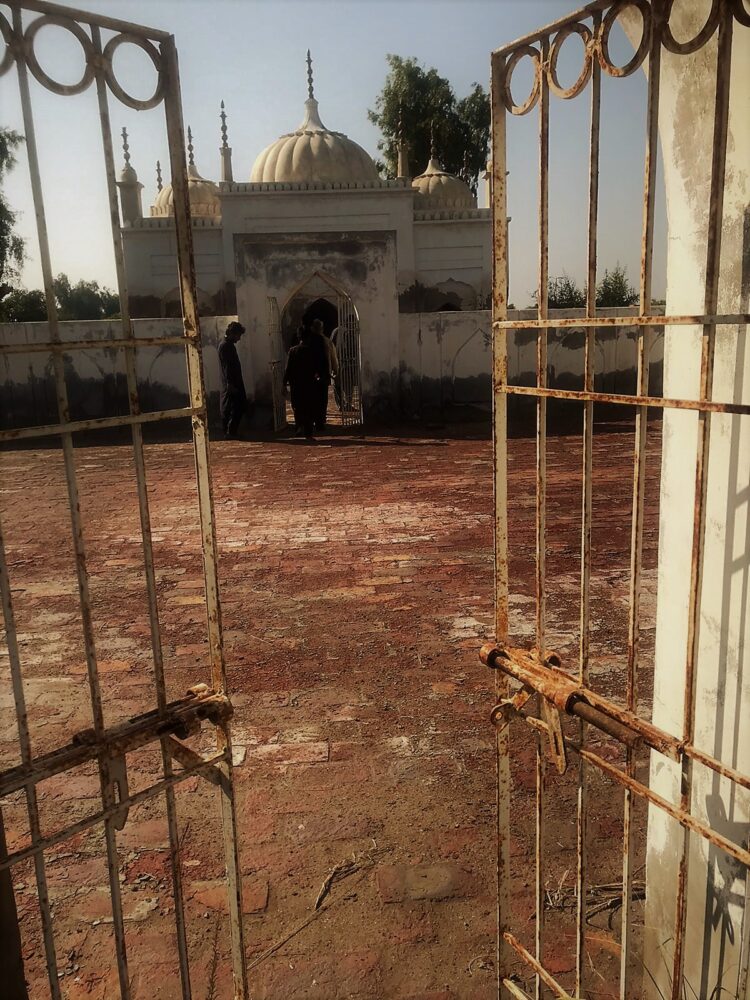
On the same day, along with some friends, I went to the common graveyard of the Miani battle. We headed towards the north, crossed some floral beds, and then from a distance I saw a white-colored mosque. Amin Joyo, a young historian, told me that people of nearby villages are of the view that along with the mosque, there was also a well. He added: “It is believed that this place was one of the outposts of the Talpurs, and the mosque and the well were constructed for the convenience of the stationed troops.” Some rose-pickers looked at us from a distance. It was strange that none of them approached us or enquired from us about our presence in the graveyard.
I noticed a middle-aged man draped in a bit loose overcoat – dark brown, made of thick fabric and decorative with wide-shoulder-buckles. But it shouldn’t be compared with Gogol’s short story The Overcoat, which shows the importance of essential material things in one’s life.
He came to the scene and silently followed us. When we were standing in front of Mir Jan Muhammad Talpur’s grave, he broke his silence and in an inaudible tone said: “Mir Jan Muhammad Talpur was the one who fought with Angrez (English people), and Mir Badshah had hidden themselves in their palaces.”
He elaborated that the Mirs’ cowardice instigated the people to send them bangles and ladies’ clothes. When we came out of the graveyard and took the muddy path that zigzagged from the fields, I heard his melodious voice. He was crooning Shaikh Ayaz’s “Vai,” sang by Fakir Abdul Ghafor. The “Vai,” along with Comrade Hyder Baksh Jatoi’s poem “Jeay Sindh, Jeay Sindh,” was a popular song in the anti-One-Unit movement. Now he raised his voice:
Sahando Ker Mayar O’ Yar,
Sindhrri Khe Sir Ker Na Dhendo
(Who among us, my friend, would bear abashing?
Of not sacrificing himself for Sindh, while a call comes?)
I didn’t realize it when he ended his singing; because I was engrossed in thoughts of my initially prepared bibliography about the Miani War.
I believe, roughly, that I have listed four dozen books about the Miani and Duabbo battles, but few books provide first-hand accounts. These books are: Records of the Irregular Horse (Volume 1), The Life and Opinions of General Sir Charles James Napier (Volume II and Volume III) and Madras Artillery Records (Volume VII).

Generally, it is believed that Sindh was conquered by the British on the 17th of February 1843, and that its defeat was completed on the 24th of March at Duabbo. However, HT Lambrick, in his article “The Sindh Battles, 1843” published by the Sindh Historical Society, has mentioned that the people of Sindh talk of the battle of the 24th of March (Duabbo) as the “Battle of Nareja Goth.” He has also mentioned that the common name of the battle of the 24th March (Duabbo) among locals is “Mir Sher Muhammad Wari Jang” (Mir Sher Muhammad’s Battle).
Now we were on the main path. It snaked onwards, being the only way to reach the metalled road. We were walking in a queue. A man from Chandia village was also walking in front of me. I asked him about the Duabbo Battle. He responded to me with a prelude that the battle was spread over miles and was called “Mir Sher Muhammad Ji Jang” (Mir Sher Muhammad’s Battle). He added: “It is said that lash (dead bodies) were in the thousands, and the wounded hid themselves in the surrounding forests and became prey to wild animals.” Later, the Governor-General’s order allowed the corps to bear the name “Hyderabad, 1843.” The word was to be mentioned in their orders, appointments, colours, and standards. They were also permitted to replace “Meanee” with “Hyderabad.” Nowadays, the Cheshire regiment veterans’ Facebook groups and private websites remember the regiment’s military campaigns and battles. One of their unofficial logos mentions the names of the battles, including Miani and Hyderabad. Some veterans’ groups prepare and sell souvenirs such as badges, table-standards and cups.
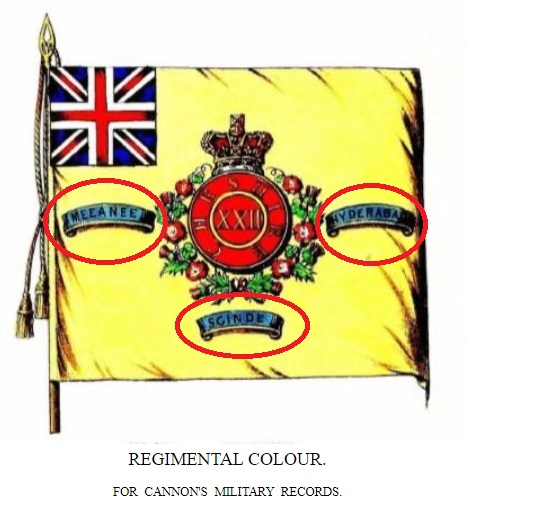 Recently published works reveal how the East India Company, a modest business enterprise, under the short period of 100 years (1757-1857) occupied 89,000 square miles out of India’s 157,000 square miles. Professor Dr. Michael H. Fisher’s edited book, The Politics of the British Annexation of India, 1757-1857’has unpacked the East India Company’s annexation process.
Recently published works reveal how the East India Company, a modest business enterprise, under the short period of 100 years (1757-1857) occupied 89,000 square miles out of India’s 157,000 square miles. Professor Dr. Michael H. Fisher’s edited book, The Politics of the British Annexation of India, 1757-1857’has unpacked the East India Company’s annexation process.
He has explained that the Company annexed through manipulation of powerful groups (tribal and feudal chiefs and members of Rajas’ Darbars), criminality, bribes and deception. Mathew A. Cook, in his recently published book Annexation and the Unhappy Valley: The Historical Anthropology of Sindh’s Colonization, has deeply explored the post-annexation phenomena in Sindh. He has highlighted the sociocultural consequences of the annexation.
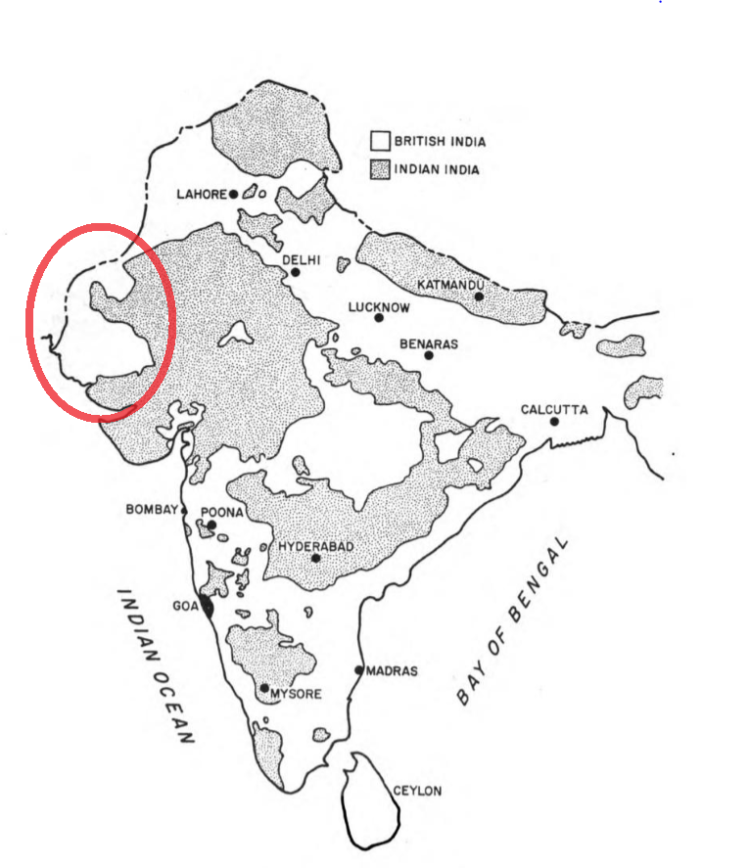
I am of the view that the East India Company’s annexation process in India, including Sindh, went through two phases. In its first phase, the Company, through its ‘residencies,’ developed military and political relationships with Rajas, Princes and Amirs. In its second phase, it reduced the power of the native states by imposing treaties, then interfering in their affairs.
Sindh’s annexation also went through the same route – exploitation, trickery, threats, agreements and battles. Resultantly, the Amirs of Sindh became weak and fragile; and gradually Sindh was fully annexed – an independent Sindh merged into an existing British polity. Now, historians have replaced the ‘annexation’ phrase with ‘occupation’, ‘battle’ and ‘war.’
Therefore, we may say that the term “Sindh’s annexation” embodies all names and moments: the Miani battle, the Duabbo battle, the Sheedi’s War, the Khanani Talpurs’ War, Sher Muhammad’s War and Hyderabad battle.
All are ways of talking about the fall of Sindh to colonial rule, in 1843.
_____________________
Dr. Zaffar Junejo has a Ph.D. in History from the University of Malaya. His areas of interest are post-colonial history, social history and peasants’ history.
Courtesy: The Friday Times Lahore